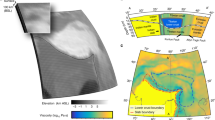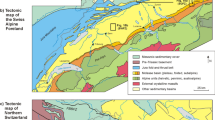Abstract
In this contribution, we present a new model of passive rifting and related rift-flank uplift. The numerical model is based on a lattice spring network coupled with a viscous particle model so that we can simulate visco-elasto-plastic behaviour with dynamic fault development. In our model, we show that rift-flank uplift can be achieved best when extension in the crust is localized and the lower crust is strong so that major rift faults transect the whole crust. Uplift of rift flanks follows a smooth function whereas down-throw in the rift basin takes place in steps. The geometry of the developing faults has also an influence on the uplift; in this case, displacement along major rift faults produces higher flanks than distributed displacement on many faults. Our model also shows that the relative elastic thickness of the crust has only a minor influence on the uplift since fault depth and elastic thickness are not independent. In addition, we show with a second set of simulations and analytically that a strain misfit between the upper and lower boundaries of a stretched crust, which is created by the horizontal extension, leads to an active uplift driven by elastic forces. We compare the numerical simulations, the analytical solution and real surface data from the Albertine rift in the East African Rift System and show that our new model can reproduce realistic features. Our two-layer beam model with strain misfit can also explain why a thick crust in the simulations can have an even higher rift flank than a thin crust even though the thin crust topography has a higher curvature. We discuss the implications of our simulations for real rift systems and for the current theory of rift-flank uplift.












Similar content being viewed by others
References
Allen PA, Allen JR (2005) Basin analysis: principles and applications. Blackwell, Oxford, p 549
Allen DN, de G (1954) Relaxation methods. McGraw-Hill, New York
Bassi G (1995) Relative importance of strain rate and rheology for the mode of continental extension. Geophys J Int 122:195–210
Bertotti G, Podladchikov Y, Daehler A (2000) Dynamic link between the level of ductile crustal flow and style of normal faulting of brittle crust. Tectonophysics 320:195–218
Bons PD, Koehn D, Jessell MW (2008) Microdynamics simulation, lecture notes in earth sciences, 106, Springer, Berlin, pp 405
Bott MHP (1996) Flexure associated with planar faulting. Geophys J Int 126:F21–F24
Brauch W, Dreyer H, Haacke W (1990) Mathematik für Ingenieure. Teubner, Stuttgart
Buck WR (1988) Flexural rotation of normal faults. Tectonics 7:959–973
Buck WR (1991) Modes of continental lithospheric extension. J Geophys Res 96:20
Burov E, Cloetingh S (1997) Rift dynamics: new thermomechanical aspects of post-rift evolution of extensional basins. Earth Planet Sci Lett 150:7–26
Carter NL, Twenn M (1987) Flow properties of continental lithosphere. Tectonophysics 136:27–63
Clyne TW (1996) Residual stresses in surface coatings and their effects on interfacial debonding. Key Eng Mater 116/117:307–330
Ebinger CJ, Bechtel TD, Forsyth DW, Bowen CO (1989) Effective elastic thickness beneath the East African and Afar Plateaux and dynamic compensation of the uplifts. J Geophys Res 94:2883–2901
Fowler C (2001) The solid earth. Cambridge University Press, Cambridge, p 472
Gölke M, Mechie J (1994) Finite-element modelling of the structure and evolution of the South Kenya Rift, East Africa. Tectonophysics 236:439–452
Govers R, Wortel MJR (1995) Extension of stable continental lithosphere and the initiation of lithospheric scale faults. Tectonics 14:1041–1055
Grah M, Alzebdeh K, Sheng P, Vaudin M, Bowman K, Ostatoja-Starzewski M (1996) Brittle intergranular failure in 2D microstructures: experiments and computer simulations. Acta Mater 44(10):4003–4018
Hampel A, Hetzel R (2006) Response of normal faults to glacial-interglacial fluctuations of ice and water masses on Earth’s surface. JGR 111:B06406. doi:10.1029/2005JB004124
Karner G, Byamungu B, Ebinger C, Kampunzu A, Mukasa R, Nyakaana J, Rubondo E, Upcott N (2000) Distribution of crustal extension and regional basin architecture of the Albertine rift system, East Africa. Mar A Petrol Geol 17:1131–1150
Koehn D, Arnold J, Passchier CW (2005) Fracture and vein patterns as indicators of deformation history: a numerical study. In: Gapais D, Brun JP, Cobbold PR (eds) Deformation mechanisms, rheology and tectonics: from minerals to the lithosphere, Geological Society of London, Special Publications 243, pp 11–24
Koehn D, Malthe-Sørenssen A, Passchier CW (2006) The structure of reactive grain boundaries under stress containing confined fluids. J Chem Geol 230:207–219
Koehn D, Francois R, Toussaint R, Passchier CW (2007) Growth of stylolite teeth patterns depending on normal stress and finite compaction. Earth Planet Sci Lett 257:582–595
Koehn D, Aanyu K, Haines S, Sachau T (2008) Rift nucleation, rift propagation and the creation of basement micro-plates within active rifts. Tectonophysics 458:105–116
Kusznir NJ, Ziegler PA (1992) Mechanics of continental extension and sedimentary basin formation: a simple/pure-shear flexural cantilever model In: Ziegler PA, Geodynamics of rifting, vol 3, Thematic discussions. Tectonophysics 215:117–131
Malthe-Sørenssen A, Walmann T, Feder J, Jøssang W, Meakin P (1998) Simulation of extensional clay fractures. Phys Rev E 58:5548–5564
McKenzie D (1978) Some remarks on the development of sedimentary basins. Earth Planet Sci Lett 40:25–32
Monette L, Anderson MP (1994) Elastic and fracture properties of the two-dimensional triangular and square lattice. Model Simul Mater Sci Eng 2:53–66
Morley CK (1999) Geoscience of rift systems-evolution of East Africa. AAPG Stud Geol 44:242
Ramberg H (1975) Particle paths, displacement and progressive strain applicable to Rocks. Tectonophysics 28:1–37
Ranalli G (1995) Rheology of the earth, 2nd edn. Chapman & Hall, London
Rowley DB, Sahagian D (1986) Depth-dependent stretching: a different approach. Geology 14:32–35
Royden L, Keen CE (1980) Rifting process and thermal evolution of the continental margin of eastern Canada determined from subsidence curves. Earth Planet Sci Lett 51:343–361
Ter Voorde M, van Balen RT, Bertotti G, Cloetingh S (1998) The influence of stratified rheology on the flexural response of the lithosphere to (un)loading by extensional faulting. Geophys J Int 134:721–735
Turcotte DL, Emermann SH (1983) Mechanisms of active and passive rifting. Tectonophysics 94:39–50
Upcott NM, Mukasa RK, Ebinger CJ, Karner GD (1996) Along-axis segmentation and isostasy in the Western rift, East Africa. J Geophys Res 101(B2):3247–3268
Van Balen R, Podladchikov YY (1998) The effects of inplane force variations on a faulted elastic thin-plate, implications for rifted sedimentary basins. Geophys Res Lett 25:3903–3906
Van Wijk JW, Blackman DK (2005) Dynamics of continental rift propagation: the end-member modes. Earth Planet Sci Lett 229:247–258
Weijermars R (1991) The role of stress in ductile deformation. J Struct Geol 13:1061–1078
Wernicke B (1981) Low angle normal faults in the Basin and Range province: nappe tectonics in an extension orogen. Nature 291:645–647
Ziegler PA (1992) Geodynamics of rifting and implications for hydrocarbon habitat. Tectonophysics 215:221–253
Acknowledgments
This project was funded by the Deutsche Forschungs Gemeinschaft (DFG) grant KO 2114/4-1 of the Forschergruppe “Rift Link”.
Author information
Authors and Affiliations
Corresponding author
Rights and permissions
About this article
Cite this article
Sachau, T., Koehn, D. Faulting of the lithosphere during extension and related rift-flank uplift: a numerical study. Int J Earth Sci (Geol Rundsch) 99, 1619–1632 (2010). https://doi.org/10.1007/s00531-010-0513-6
Received:
Accepted:
Published:
Issue Date:
DOI: https://doi.org/10.1007/s00531-010-0513-6




